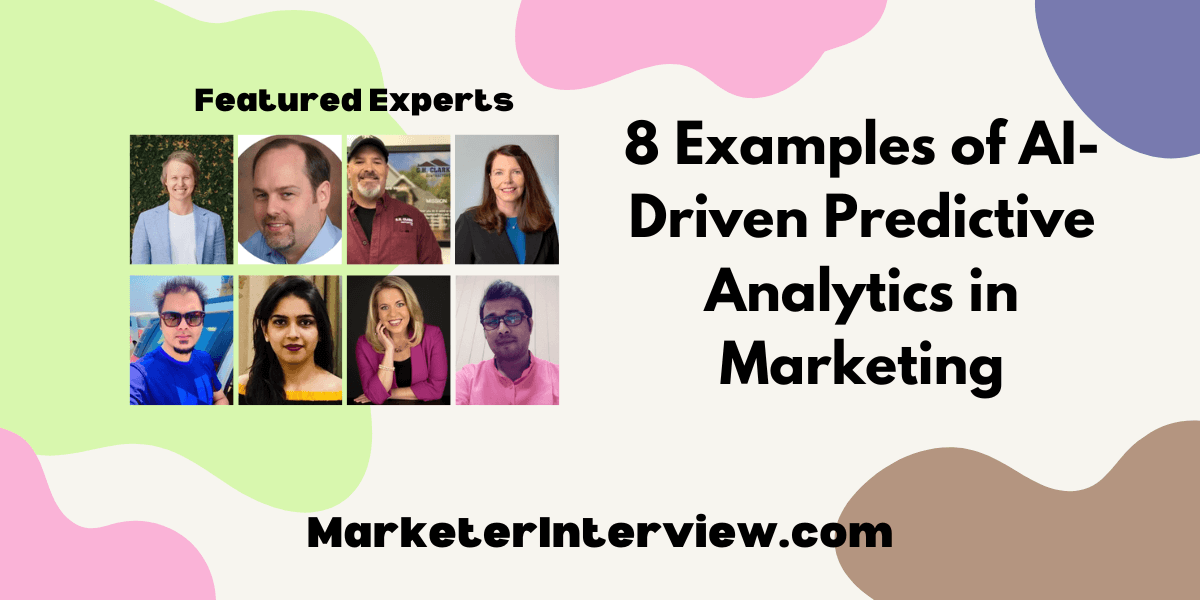8 Examples of AI-Driven Predictive Analytics in Marketing
Exploring the cutting-edge intersection of artificial intelligence and marketing, we’ve gathered insights from founders, CEOs, and directors. From how Netflix personalizes viewer recommendations to optimizing social media ads through AI, discover the top eight examples of AI-driven predictive analytics as shared by these industry experts.
Want to get quoted in MarketerInterview.com content just like this? Apply to become a contributor today!
Contents
- 1 Personalize Viewer Recommendations like Netflix
- 2 Optimize Email Campaigns with AI
- 3 Use AI Predictive Analytics in Search and Ads
- 4 Predict Customer Purchase Behavior
- 5 Forecast Customer Churn like American Express
- 6 Identify Customer Lifetime Value with AI
- 7 Refine Target Audience for Product Launch
- 8 Implement Social Media Ad Insights
Personalize Viewer Recommendations like Netflix
One specific example of AI-driven predictive analytics in marketing is Netflix’s use of machine learning to recommend shows and movies to its users. The AI analyzes past viewing habits to predict what a subscriber might like to watch next. This personalized recommendation system is believed to save Netflix around $1 billion per year by keeping subscribers engaged with content they enjoy.

Casey Jones, Founder, Head of Marketing, CJ&CO
Optimize Email Campaigns with AI
AI-driven predictive analytics can help optimize your marketing campaigns in various ways. One way we have found to be consistently successful is by using AI predictive analytics in our email marketing and marketing automation efforts.
Email marketing is essential to the success of your marketing program. It is the most cost-effective way to stay engaged and top-of-mind with your customers and prospects. However, email needs to be done strategically to have the most impact on your marketing program. We see an increase in email open rates and click-through rates by using send-time optimization AI for email delivery.
Send-time optimization for email marketing allows companies to send emails to their contacts on the day of the week and the time of the day that they are most likely to engage. This data is derived from information stored in your CRM, showing how contacts are already engaging with email based on the day of the week and time of day. This enables companies to not only customize the content of emails, which is also very important, but also personalize the actual delivery of the email, which has an exponential impact on email marketing engagement. This means your prospects and customers will receive the email in their inbox when they are most likely to open and click.
We have seen all of our clients experience an increase in both email open rates and click rates when implementing send-time optimization in their email strategy because it takes the guesswork out of when to send an email and allows us to leverage AI predictive analytics to drive the email deployment strategy.

Elyse Flynn Meyer, Owner & Founder, Prism Global Marketing Solutions
Use AI Predictive Analytics in Search and Ads
In terms of marketing, AI predictive analytics empowers marketers to make informed decisions, personalize marketing efforts, and improve overall campaign effectiveness. This also allows them to plan better customer engagement and increase profits. A perfect example of AI-driven predictive analytics is the Google search engine.
Once you search for a product on Google, you find pop-ups of the same products across all platforms, such as social media. Another platform that promotes AI predictive marketing is Airbnb. This homestay platform increased its sales through repetitive advertisements that lead customers to make decisions in favor of the company. AI predictive analytics in marketing ensures consistent growth by tracking trends and consumer behavior in the market.

Shreya Patel, Director, Travel Portal Solution
Predict Customer Purchase Behavior
One specific example of AI-driven predictive analytics in marketing is the use of machine-learning algorithms by an e-commerce company to predict customer purchase behavior.
By analyzing vast amounts of data from previous purchases, browsing history, and customer interactions, the AI model was able to forecast which products individual customers were likely to buy in the future. This enabled the company to personalize marketing emails and online advertisements, significantly increasing conversion rates and customer satisfaction by delivering relevant content and offers.
Madison T, Ecommerce Manager, My Supplement Store
Forecast Customer Churn like American Express
Customer churn, or the rate at which customers cease doing business with a company, is an important metric. Predicting this factor can help enterprises lower the churn rate and retain customers before they leave.
American Express has used AI-driven predictive analytics in its email marketing. The company employed machine-learning algorithms to analyze customers’ transaction data. It helped them identify patterns indicating potential churn. Using that data, they modified their marketing campaigns to meet individual needs with special deals and offers for customers with a high churn risk.
It increased their customer engagement and retention rates and eventually led to higher profits!

Faizan Khan, Public Relations and Content Marketing Specialist, Ubuy UK
Identify Customer Lifetime Value with AI
An exemplary use of AI-driven predictive analytics in marketing is the implementation of customer lifetime value (CLV) prediction models. By leveraging AI algorithms, businesses can analyze vast sets of customer data to forecast the potential value of a customer over their entire relationship with the company. This empowers marketers to make informed decisions regarding resource allocation, personalized marketing strategies, and customer retention initiatives.
Through predictive analytics, AI can identify high-value customers, anticipate their future needs, and recommend tailored marketing approaches to maximize their lifetime value. This not only optimizes marketing expenditure but also cultivates stronger customer relationships, ultimately leading to increased profitability and sustained business growth. The application of AI-driven predictive analytics, particularly in CLV modeling, exemplifies the profound impact of AI in shaping future-focused marketing strategies.

Merry Fountain, Indiana Accident Lawyer, Fountain Law Firm
Refine Target Audience for Product Launch
One standout example is how we utilized AI-driven predictive analytics to refine our target audience for a product launch. By analyzing past customer behavior and demographic data, the AI predicted which segments were most likely to convert. This enabled us to tailor our marketing efforts precisely, resulting in a significant increase in conversion rates and a higher ROI compared to traditional methods.

Gil Clark Jr., CEO, GH Clark
Implement Social Media Ad Insights
Recently, my team utilized AI-driven predictive analytics to optimize our social media ad placements. The AI system analyzed vast amounts of engagement data to forecast the best times and platforms for posting our ads, tailored to our target demographic’s online behavior patterns.
Implementing these insights, we achieved a remarkable increase in ad engagement rates by 30% and a reduction in cost per click by 20%. This strategy proved invaluable in maximizing our ad spend efficiency and ensuring our content reached the right audience at the optimal moment, illustrating the power of predictive analytics in fine-tuning marketing efforts.

David Wilfong, Founder and CEO, DavidWilfong
Want to get quoted in MarketerInterview.com content just like this? Apply to become a contributor today!






